I always jump at the chance to write about music. Sadly it’s been a while. Music writing is something I love to do, especially when it involves the work of Jez Conlon, a friend and artist I’ve written about previously here on Circus Folk. Cloud Sequence heralds a new artistic collaboration for Jez, mostly known for their work and collaborations under the banner of Cooperblack. This is a a critical response to a new work by Cloud Sequence, and a paid post. Forming in 2019, Cloud Sequence is Saar Amptmeijer from Utrecht, the Netherlands (an accomplished, highly progressive multi-modal artist), and Jez Conlon (a talented musician, composer and sound producer) from Adelaide, South Australia. Both live and work in Mparntwe/Alice Springs in…

Stories from inside life’s big top.
Posts from the “art” Category
Not long ago, a ‘call to action’ floated across my social feeds. “Gondola. Need one. Anyone selling theirs? Or could help hook a sista up?” It was from Melbourne artist Laila Marie Costa, an old friend of a friend whose art I’ve seriously admired for many years. Given her line of work it wasn’t unusual. She wasn’t kidding either. Reaching deep into her Italian heritage and harking the call of refused, obsolete, junk objects – the addiction fever-grip to which she’s been answering her entire artistic life – I intuited she was in the throes of (another) new upcycling project… While the self-described “creator of art stuff… curator of collections, riffage musician and champion weeder” later told me she “wasn’t…
Earlier this year, after travelling many miles and relocating for the umpteenth time in my life, I was lucky enough to be on the receiving end of a lovely act of kindness. It happened when I met Australian collage artist Karen Lynch in person for the first time. I’d recently moved to the “southern creep” of Adelaide, Karen’s home city. On a sunny day in May we arranged to catch up in one of the sleepy seaside villages between our respective suburbs that only ‘the locals’ know about. We’d been ‘virtual’ blogging buddies for 4 years, encouraging each other and interacting as co-members of the very first intake of Pip Lincolne‘s ‘Blog With Pip’ (an online “how to” course for bloggers),…
It’s amazing who you meet in Berlin… Artists are drawn to the city as if it were a kind of mythic, spiritual ‘big top’, seeking artistic inspiration, like-minded community and creative challenge. Something I’ve written about time and time again here at Circus Folk! Mark Ogge is one such ‘pilgrim’. Hailing from Melbourne, Australia – and the brother of one of my dearest friends – Mark’s an “internationally renowned” mid-career artist with a passion for making images inspired by “the rich history of fairground and theatrical art”, the circus, vaudeville and Commedia dell’Arte. Having studied all of the above, in 2001 he painted the Famous Spiegeltent Facade under which thousands have sat during Melbourne festivals (and elsewhere around the world). Also…
Tagged: art, artist, circus automata, commedia dell'arte, famous speigeltent, mark ogge, painting
I’ve been putting off writing this. Since last Friday. The day Hugh Waller left our world for another. Hugh Walter John Waller. Born October 23, 1959. Died June 16, 2017. Hugh was a friend from Bendigo, the regional centre in Australia where I lived before coming to Berlin. I’d not long been in town. I’d seen Hugh around at art shows but we first ‘properly’ met at a group exhibition at Dudley House, a fundraiser Hugh had organised for the catastrophic floods that had recently swept through the region. (I soon learned such generosity was typical of his nature.) We took to each other straight away, the professional turning social pretty quick – with Oliver too, my husband. Not long…
Tagged: bendigo, digital art, hugh waler art, hugh waller, tribute
“The crystals may be obtained for examination by covering a minute drop of blood with a glass slide, and after adding water, alcohol, or ether, to permit a gradual evaporation to ensue.” – ‘A Text-Book on Physiology’, John William Draper, M.D., 1866. The cover art from Kris Keogh‘s new record is taken from a centuries-old old medical journal. It’s the sketch of a microscopic view of ‘crystallized’ blood cells. Ornate, fragile, and frozen in time, the illustration distills the process of life and death. The blood crystals, inert and no longer living, reveal in delicate, minute detail, the miracle of life – the very blood that supplies our bodies with oxygen, the breath of life. It’s the perfect visual metaphor for…
History is littered with creative siblings, often in music, sometimes in film, occasionally in literature… See the Sisters Bronte and Arquette; the Brothers Grimm and Gibb; the Coen Brothers, Baldwins, Wachowskis and Gershwins; soft-pop super-duo The Carpenters, hard-rock guitar heroes Malcolm and Angus. The families Corr, Barrymore, Boyd and Mora. Then there are my personal faves, Ann and Nancy Wilson from Heart. Seventies AM rock would have been nothing without these sisters, nor their songs Barracuda and Crazy On You. Nothing. It’s come time to add a pair of visual artist sisters to the list: Lucy Dyson and Molly Dyson. Both are from Australia. Both live in Berlin. And both are starting to leave their mark in a serious way. …
I’ve always been fond of ‘goo’. It’s the name of my favorite Sonic Youth album. It’s one of my favorite words, caught somewhere between “coo” and “gum”. And ‘goo’ has always been one of my favorite things to eat, especially if it’s coloured pastel pink. Growing up in the 70s I consumed my fair share, especially ‘Junket‘, one of my mother’s specialties. It would arrive as ‘sweets’ at dinner parties, often on the heels of pineapple ham steaks or chicken chow mein. It was the gelatinous, wobbly version of musk sticks, fridge-set, in tall curvy glasses on stems. A sugar coma in the making, us kids couldn’t get enough of it. All these years later and on the other side…
Tagged: art, berlin, künstlerhaus benthanien, lyndal walker, photography
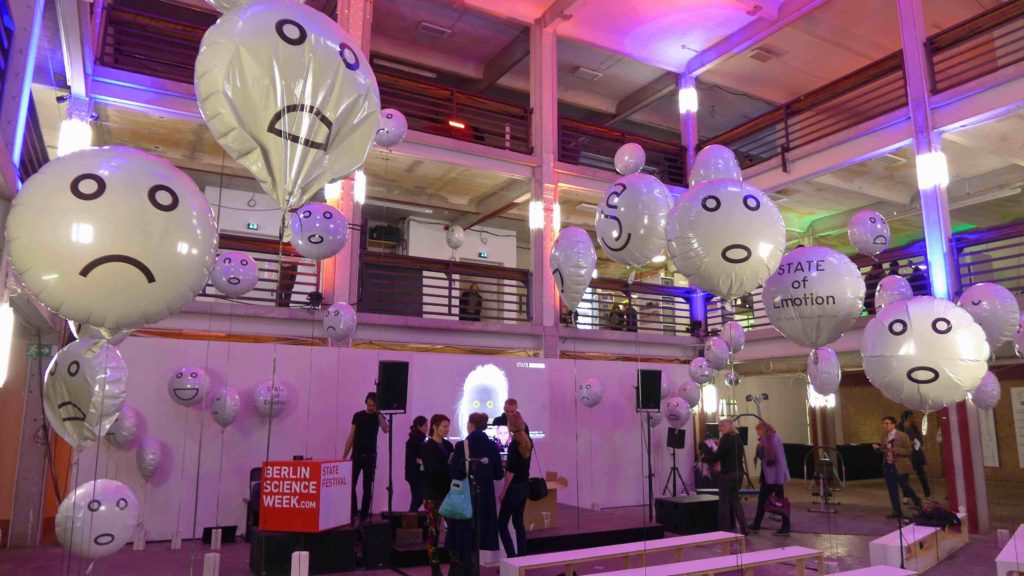
State Festival 2016, at Külhaus, Berlin. Photo: Megan Spencer (c) 2016
In November I had the good fortune to attend STATE Festival, a festival for “Open Science, Art and Society” at Kühlhaus, Berlin.
When Berlin turns on a good festival, you really feel it. I had the same range of happy emotions and visceral engagement coursing through my body at spectacular sound festivus Berlin Atonal in 2015.
Now in its second year, the theme for this year’s STATE was “Emotion: The Sentimental Machine.” Scientists, researchers, artists, makers, musicians and thinkers from Germany and beyond contributed to what was an incredibly exciting and progressive program, split into several strands: a two-day conference (where research papers were shared), public talks, interactive art installations, workshops, films, and an extensive pre-program of pop-up labs and workshops, where inter-disciplinary collaborators were brought together to work on various projects, some with seriously fascinating implications for society and culture.
The opening night “Warm Up” event manifested as A Night At The Museum, with the main room of Berlin’s famed Naturkundmuseum (“Natural History Museum”) opening to festival guests and the public.
Wandering among the interactive installations, beautifully displayed fossils and spectacularly lit dinosaurs, I half expected the prehistoric beasts to come to life in a ‘ta-daa’ moment of event-appropriate surprise. Once the jungle-esque soundscape by DJ Grizzly subsided, key note speeches began. We listened to STATE’s founder Dr. Christian Rauch, (a physicist with a PhD in nanoscience and excellent taste in electronica), the museum’s Head of Science Programme & Public Engagement Dr. Katrin Vohland and primate research scientist Dr. Katja Liebal, who gave a glimpse into her animal emotions research project with primates.
The night set the tone for what was an incredibly exuberant, optimistic and progressive few days: the festival celebrates not only science but its intersections and cross-pollination with other modalities and disciplines – namely the arts, philosophy, medicine and design. Oh – and the public.
“Affective research” was high on the agenda with a number of conference panels devoted to the neuroscience behind affect and empathy. Creative research methods were also advocated – including communicating findings via storytelling and creating “narratives” around data. Open source science and “citizen science” were also embraced, with Katrin Vohland openly declaring Naturkundmuseum’s advocacy for public involvement in scientific “deliberation” during her opening night speech. Word was out: the scientific community needs to change tack if it’s going to be relevant in – and make an impact on – today’s “post truth” society.
“Emotions seem to play an increasing role in science and science communication,” she said in her speech. “Scientists have to pack their results into stories. Some researchers already talk about the post-factual era we are entering, opening the room for populism and manipulation.”
Could science be letting go of its long-held aversion towards ‘affect’? Is “subjectivity the new black”? Listening to the STATE 2016 discourse, the answer is a resounding ‘yes’.
As we poked around the exhibits opening night, it felt like a dance party for curious people, observing, listening and discussing in unadulterated awe and wonder. It was nice to feel that way again – like delighted, curious children discovering the world for the first time.
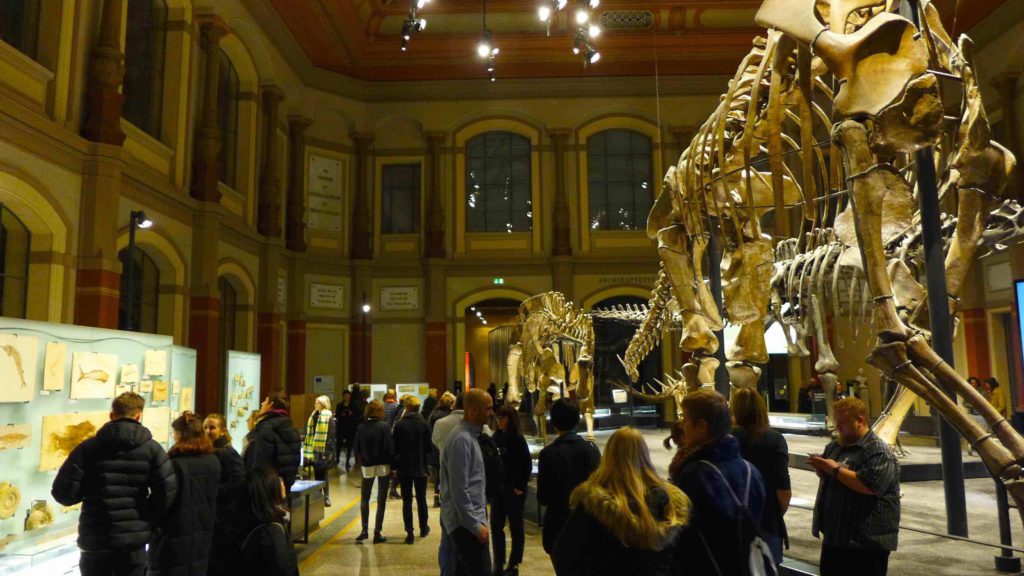
Walking with dinosaurs at STATE Festival Opening Night. Photo: Megan Spencer (c) 2016
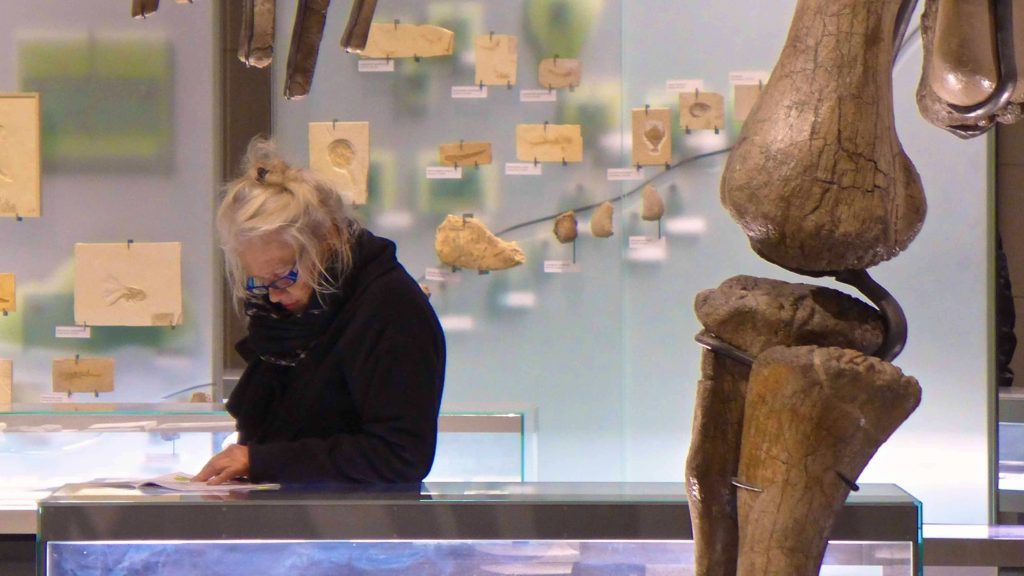
‘Dem bones’. Opening night at Naturkundmuseum, STATE Festival 2016. Photo: Megan Spencer (c) 2016
One of the projects that piqued my curiosity was ‘Digesting The Anthropocene‘, devised by American “experimental philosopher” and conceptual artist, Jonathan Keats. Namely as it made manifest the link between mind and body, and the capacity we have for intelligence using our senses (an embodied experience of knowledge, as opposed to purely a cognitive one.) It is based around his theory of “gastronification”, what he calls “an alternative tool for visualising big data”.
“Data gastronification is where we might engage the emotional cognition of people’s stomachs and intestines in getting a better understanding of “wicked” problems involving a huge number of different data sets and influencing factors, such as for example, in anthropogenic (human influenced) climate change.”
“Instead of visualizing model projections for processing by the visual cortex and brain, Keats’ method makes the data ‘fit for consumption’, literally: flow diagrams are reformulated as recipes, which can be cooked up and digested. Different scenarios and conditions will now be represented in culinary terms.” (Description from STATE catalogue.)
His local collaborators were David Marx, founder of Berlin food lab Science Kitchen; scientific researchers at Berlin’s Futuruim Project, and designer and data visualization specialist Stefan Thiel. The team worked with Keats in an attempt to make the science around climate change “digestible” for the general public, coming up with a recipe for ‘climate change sorbet’ based on three flavour profiles:
- Green = low greenhouse gas emissions.
- Blue = medium C02 emissions, and
- Turquoise = high fossil fuel emissions.
The hope being (from my interpretation of it anyway), to create a more inclusive public conversation around the problem of climate change – ie a deeper, less fraught engagement with the problem based on intuitive perception – so that taking action might become a reality rather than a political football.
To, as it were, create a solution through shared ‘gut feeling’.
It’s a very exciting idea, especially as the scientific evidence around mind/body medicine continues to grow, and the bias against ‘affect’, subjectivity and emotion within the scientific world, diminishes. Listen to my full interview with Jonathon Keats at the audio link below.
Other highlights from my STATE Festival experience:
- Listening to the research findings of Cornell University emotions researchers Dr. Adam Anderson and Dr. Eve de Rosa in their work around using feelings or “affect” as valid measures of perception;
- Dr . Helen Stark’s paper about the “History of Emotion'” and “The Man Of Feeling” in the Romantic period of literature (Queen Mary University of London);
- Receiving an immersive sound and touch massage from “sensation composer” Jacques-André Dupont and instrument designer/music composer Clément Destephen, as part of their MIM installation (“The Medium Is The Massage”). It was so beautiful I was moved to tears, and
- Seeing Werner Herzog’s documentary about the digital age, ‘Lo And Behold: Reveries of the Connected World.’ Sad, funny, frightening, and vintage Herzog.
* * *
And my festival rating? Big happy face emoji : )
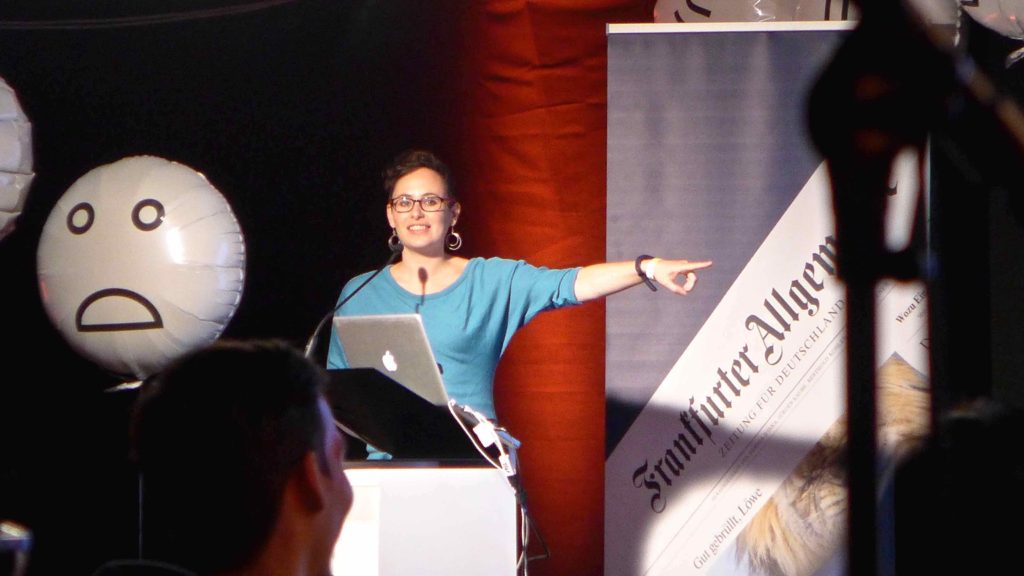
Woman of feeling: Dr. Helen Stark, delivering her paper about ‘The Man of Feeling’ in the history of Romantic Literature. Photo: Megan Spencer (c) 2016
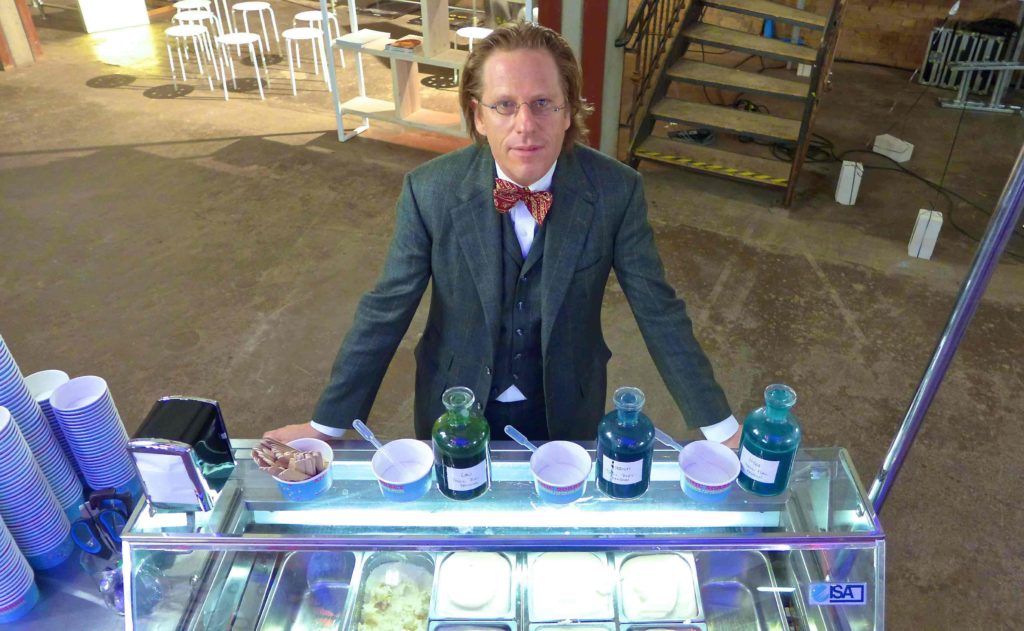
Digesting climate change: Jonathon Keats at STATE Festival, 2016. Photo: Megan Spencer (c) 2016
* * *
Words, images and sound (c) Megan Spencer 2016.
- Discover: the STATE Festival program
- View: my STATE Festival photo album
- Eat: the Climate Change Sorbet photo album
- Listen: to my STATE Festival report on Radio National
- Hear: the entire Jonathan Keats interview on Soundcloud
- Visit: STATE Festival on Facebook
Many thanks to the STATE Festival team for support, and to Jonathon Keats for the interview.
“Greg Miller is one of the photographers who inspires me. I love the aesthetic of his work: the people he photographs are positioned like mannequins and sometimes appear stuck in time. He doesn’t have a huge following on Instagram but he’s one those photographers who deserves a bigger one.” A degree of urgency accompanies this communiqué. I open my inbox only to have its words leap on me, wiping sweat off their brow. I sit up and take notice. Sent to me by Australian photographer Penelope Scanlan, this is the last in a raft of emails we’ve sent each other over an arc of two years. On an unexpected trip back to Australia this year, I manage to get my shit together…
Tagged: australia, bendigo, greg miller, instagram, penelope scanlan, photography